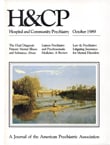An Integrated Treatment Model for Dual Diagnosis of Psychosis and Addiction
Abstract
A model that integrates the treatment of patients with a dual diagnosis of psychosis and addiction has been developed on a general hospital psychiatric unit. The model emphasizes the parallels between the standard biopsychosocial illness-and-rehabilitation model for treatment of serious psychiatric disorders and the 12-step disease-and-recovery model of Alcoholics Anonymous for treatment of addiction. Dual-diagnosis patients are viewed as having two primary, chronic, biologic mental illnesses, each requiring specific treatment to stabilize acute symptoms and engage the patient in a recovery process. An integrated treatment program is described, as are the steps taken to alleviate psychiatric clinicians' concerns about patient involvement in AA and addiction clinicians' discomfort with patients' use of medication.
Access content
To read the fulltext, please use one of the options below to sign in or purchase access.- Personal login
- Institutional Login
- Sign in via OpenAthens
- Register for access
-
Please login/register if you wish to pair your device and check access availability.
Not a subscriber?
PsychiatryOnline subscription options offer access to the DSM-5 library, books, journals, CME, and patient resources. This all-in-one virtual library provides psychiatrists and mental health professionals with key resources for diagnosis, treatment, research, and professional development.
Need more help? PsychiatryOnline Customer Service may be reached by emailing [email protected] or by calling 800-368-5777 (in the U.S.) or 703-907-7322 (outside the U.S.).



